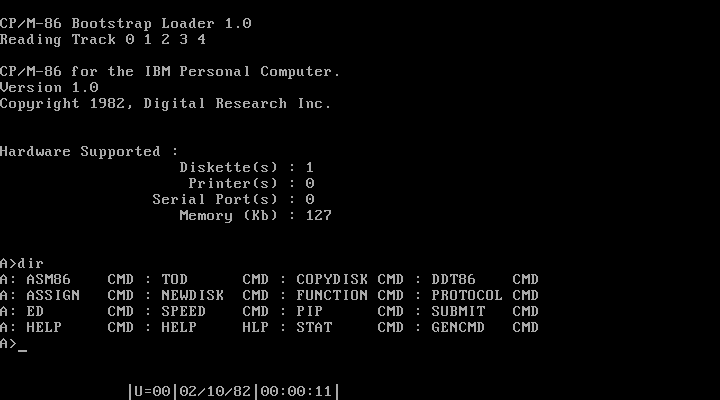|
Altos Computers
Altos Computer Systems was founded in 1977 by David G. Jackson and Roger William Vass Sr. It focused on small multi-user computers, starting with multi-user derivatives of CP/M, and later including Unix and Xenix-based machines. In its 1982 initial public offering on NASDAQ, the company raised $59M. Thereafter the company's stock was traded under the symbol ALTO. Coming under increasing pressure from competitors in the server market, such as Compaq and Sun Microsystems, Altos posted a $5M loss (its first ever) in the fiscal year ending in June, 1989. In the aftermath, Altos was acquired by Acer in 1990 for $94M, although mostly for its US distribution channels rather than its technology. Shortly before this acquisition, there were about 128,000 Altos systems installed throughout the world. Company history and products According to a brief history of the company, which ran as an advertisement on their 10th anniversary, Altos Computer Systems was started by Dave Jackson in 1977 ... [...More Info...] [...Related Items...] OR: [Wikipedia] [Google] [Baidu] |
Public Company
A public company is a company whose ownership is organized via shares of share capital, stock which are intended to be freely traded on a stock exchange or in over-the-counter (finance), over-the-counter markets. A public (publicly traded) company can be listed on a stock exchange (listing (finance), listed company), which facilitates the trade of shares, or not (unlisted public company). In some jurisdictions, public companies over a certain size must be listed on an exchange. In most cases, public companies are ''private'' enterprises in the ''private'' sector, and "public" emphasizes their reporting and trading on the public markets. Public companies are formed within the legal systems of particular states and so have associations and formal designations, which are distinct and separate in the polity in which they reside. In the United States, for example, a public company is usually a type of corporation, though a corporation need not be a public company. In the United Kin ... [...More Info...] [...Related Items...] OR: [Wikipedia] [Google] [Baidu] |
Shugart Associates
Shugart Associates (later Shugart Corporation) was a computer peripheral manufacturer that dominated the floppy disk drive market in the late 1970s and is famous for introducing the -inch "Minifloppy" floppy disk drive. In 1979 it was one of the first companies to introduce a hard disk drive form factor compatible with a floppy disk drive, the SA1000 form factor compatible with the 8-inch floppy drive form factor. Founded in 1973, Shugart Associates was purchased in 1977 by Xerox, which then exited the business in 1985 and 1986, selling the brand name and the 8-inch floppy product line (in March 1986) to Narlinger Group, which ultimately ceased operations circa 1991. History Beginnings After a distinguished career at IBM and a few years at Memorex, Alan Shugart decided to strike out on his own in 1973. After gathering venture capital, he started Shugart Associates. The original business plan was to build a small-business system (similar to the IBM 3740) dealing with the developm ... [...More Info...] [...Related Items...] OR: [Wikipedia] [Google] [Baidu] |
CP/M-86
CP/M-86 is a discontinued version of the CP/M operating system that Digital Research (DR) made for the Intel 8086 and Intel 8088. The system commands are the same as in CP/M-80. Executable files used the relocatable .CMD file format. Digital Research also produced a multi-user multitasking operating system compatible with CP/M-86, MP/M-86, which later evolved into Concurrent CP/M-86. When an emulator was added to provide PC DOS compatibility, the system was renamed Concurrent DOS, which later became Multiuser DOS, of which REAL/32 is the latest incarnation. The FlexOS, DOS Plus, and DR DOS families of operating systems started as derivations of Concurrent DOS as well. History Digital Research's CP/M-86 was originally announced to be released in November 1979, but was delayed repeatedly. When IBM contacted other companies to obtain components for the IBM PC, the as-yet unreleased CP/M-86 was its first choice for an operating system because CP/M had the most applica ... [...More Info...] [...Related Items...] OR: [Wikipedia] [Google] [Baidu] |
Intel 8086
The 8086 (also called iAPX 86) is a 16-bit computing, 16-bit microprocessor chip designed by Intel between early 1976 and June 8, 1978, when it was released. The Intel 8088, released July 1, 1979, is a slightly modified chip with an external 8-bit Bus (computing), data bus (allowing the use of cheaper and fewer supporting Integrated circuit, ICs),Fewer TTL buffers, latches, multiplexers (although the amount of TTL logic was not drastically reduced). It also permits the use of cheap 8080-family ICs, where the 8254 CTC, Intel 8255, 8255 PIO, and 8259 PIC were used in the IBM PC design. In addition, it makes PCB layout simpler and boards cheaper, as well as demanding fewer (1- or 4-bit wide) DRAM chips. and is notable as the processor used in the original IBM Personal Computer, IBM PC design. The 8086 gave rise to the x86 architecture, which eventually became Intel's most successful line of processors. On June 5, 2018, Intel released a limited-edition CPU celebrating the 40th anniv ... [...More Info...] [...Related Items...] OR: [Wikipedia] [Google] [Baidu] |
Intel 8080
The Intel 8080 is Intel's second 8-bit computing, 8-bit microprocessor. Introduced in April 1974, the 8080 was an enhanced successor to the earlier Intel 8008 microprocessor, although without binary compatibility.'' Electronic News'' was a weekly trade newspaper. The same advertisement appeared in the :File:Intel 8080 Advertisement May 1974.jpg, May 2, 1974, issue of ''Electronics'' magazine. Originally intended for use in Embedded system, embedded systems such as calculators, cash registers, computer terminals, and industrial robots, its robust performance soon led to adoption in a broader range of systems, ultimately helping to launch the microcomputer industry. Several key design choices contributed to the 8080’s success. Its 40‑pin package simplified interfacing compared to the 8008’s 18‑pin design, enabling a more efficient data bus. The transition to NMOS logic, NMOS technology provided faster transistor speeds than the 8008's PMOS logic, PMOS while also simplifyin ... [...More Info...] [...Related Items...] OR: [Wikipedia] [Google] [Baidu] |
Order Entry
An order management system, or OMS, is a computer software system used in a number of industries for order entry and processing. Electronic commerce and catalogers Orders can be received from businesses, consumers, or a mix of both, depending on the products. Offers and pricing may be done via catalogs, websites, or roadcast networkadvertisements. An integrated order management system may encompass these modules: * Product information (descriptions, attributes, locations, quantities) * Inventory available to promise (ATP) and sourcing * Vendors, purchasing, and receiving * Marketing (catalogs, promotions, pricing) * Customers and prospects * Order entry and customer service (including returns and refunds) * Financial processing (credit cards, billing, payment on account) * Order processing (selection, printing, picking, packing, shipping) There are several business domains which use OMS for different purposes but the core reasons remain the same: # Telecom – To keep track of cu ... [...More Info...] [...Related Items...] OR: [Wikipedia] [Google] [Baidu] |
Computerworld
''Computerworld'' (abbreviated as CW) is a computer magazine published since 1967 aimed at information technology (IT) and Business computing, business technology professionals. Original a print magazine, ''Computerworld'' published its final print issue in 2014; since then, it has been available as an online news website and as an online magazine. As a printed weekly during the 1970s and into the 1980s, ''Computerworld'' was the leading trade publication in the data processing industry. Based on circulation and revenue it was one of the most successful trade publications in any industry. Later in the 1980s it began to lose its dominant position. It is published in many countries around the world under the same or similar names. Each country's version of ''Computerworld'' includes original content and is managed independently. The publisher of ''Computerworld'', Foundry (formerly IDG Communications), is a subsidiary of International Data Group. History The publication was lau ... [...More Info...] [...Related Items...] OR: [Wikipedia] [Google] [Baidu] |
Zilog Z8000
The Zilog Z8000 is a 16-bit microprocessor architecture designed by Zilog and introduced in early 1979. Two chips were initially released, differing only in the width of the address bus; the Z8001 had a 23-bit bus while the Z8002 had a 16-bit bus. Bernard Peuto designed the architecture, while Masatoshi Shima did the logic and physical implementation, assisted by a small group. In contrast to most designs of the era, the Z8000 does not use microcode, which allowed it to be implemented in only 17,500 transistors. The Z8000 is not Z80-compatible, but includes a number of design elements from it, such as combining two registers into one with twice the number of bits. The Z8000 expanded on the Z80 by allowing two 16-bit registers to operate as a 32-bit register, or four to operate as a 64-bit register. Although it saw some use in the early 1980s, it was never as popular as the Z80. It was released after the 16-bit 8086 (April 1978) and the same time as the less-expensive 8088, a ... [...More Info...] [...Related Items...] OR: [Wikipedia] [Google] [Baidu] |
XIOS
MP/M (Multi-Programming Monitor Control Program) is a discontinued multi-user version of the CP/M operating system, created by Digital Research developer Tom Rolander in 1979. It allowed multiple users to connect to a single computer, each using a separate terminal. MP/M was a fairly advanced operating system for its era, at least on microcomputers. It included a priority-scheduled multitasking kernel (before such a name was used, the kernel was referred to as the ''nucleus'') with memory protection, concurrent input/output (XIOS) and support for spooling and queueing. It also allowed for each user to run multiple programs, and switch between them. MP/M platforms MP/M-80 The 8-bit system required a 8080 (or Z80) CPU and a minimum of 32 KB of RAM to run, but this left little memory for user applications. In order to support reasonable setups, MP/M allowed for memory to be switched in and out of the machine's "real memory" area. So for instance a program might be ... [...More Info...] [...Related Items...] OR: [Wikipedia] [Google] [Baidu] |
Bank Switching
Bank switching is a technique used in computer design to increase the amount of usable memory beyond the amount directly addressable by the Processor (computing), processor instructions. It can be used to configure a system differently at different times; for example, a read-only memory, ROM required to booting, start a system from diskette could be switched out when no longer needed. In video game systems, bank switching allowed larger games to be developed for play on existing consoles. Bank switching originated in minicomputer systems. Many modern microcontrollers and microprocessors use bank switching to manage random-access memory, non-volatile memory, input-output devices and system management registers in small embedded systems. The technique was common in 8-bit microcomputer systems. Bank-switching may also be used to work around limitations in address bus width, where some hardware constraint prevents straightforward addition of more address lines, and to work around li ... [...More Info...] [...Related Items...] OR: [Wikipedia] [Google] [Baidu] |

